Optical and Microphysical Properties of Aged Biomass Burning Aerosols and Mixtures, Based on 9-Year Multiwavelength Raman Lidar Observations in Athens, Greece
Abstract
:1. Introduction
2. Materials and Methods
2.1. Aerosol Classification—SCAN
2.2. Aerosol Optical Properties Retrieval—SCC
2.3. Aerosol Microphysical Properties Retrieval
3. Results
3.1. General Observations
3.2. Aerosol Optical and Microphysical Properties
4. Discussion
5. Conclusions
- We studied 34 aerosol layers derived from multiwavelength (3β + 2α) lidar data measured over a 9-year period (i.e., 2011–2019) over the city of Athens at the suburban site of the National and Technical University of Athens;
- We obtained the following three aerosol categories: smoke, smoke + continental polluted, and smoke + mixed dust. The smoke category consisted mostly of aerosols containing carbonaceous compounds; the continental polluted particles mostly contained a mixture of trace elements and water-soluble ions, and the mixed dust category contained a mixture of minerals;
- We retrieved the optical and microphysical properties of BB aerosols and their mixtures.
- A positive correlation between the LR532/355 variable and the time that the air mass had spent over the burned area for the s aerosol category, which seems not to be the case for the s+cp category;
- Higher LR mean values at 532 nm than 355 nm;
- High discrepancy per aerosol cluster for the vd mean values, taking a maximum under the s+cp aerosol category;
- The microphysical properties of the s+cp aerosol category and the corresponding values of SSA at UV and IR are the first to be introduced into the literature with this study.
- It is important to have as large data set as possible in order to have statistically valid results;
- The non-sphericity of the aerosols in a mixture must be taken into consideration during the retrieval of microphysical aerosol properties;
- The uncertainties of the SCAN algorithm should be examined.
Author Contributions
Funding
Data Availability Statement
Acknowledgments

Conflicts of Interest
Appendix A
| No | Date | Bottom | Top | Aerosol Category |
|---|---|---|---|---|
| 1 | 20110516 | 3062 | 3542 | s |
| 9 | 20120326 | 2402 | 3182 | s |
| 13 | 20121025 | 2282 | 2522 | s |
| 21 | 20140901 | 3422 | 3902 | s |
| 27 | 20160915 | 3002 | 3242 | s |
| 34 | 20190909 | 2522 | 3062 | s |
| 2 | 20110630 | 1502 | 1922 | s+cp |
| 6 | 20110915 | 1442 | 2042 | s+cp |
| 7 | 20120315 | 1622 | 2042 | s+cp |
| 10 | 20120406 | 1442 | 2102 | s+cp |
| 16 | 20140523 | 1082 | 2042 | s+cp |
| 18 | 20140622 | 1382 | 2102 | s+cp |
| 20 | 20140724 | 1322 | 1622 | s+cp |
| 23 | 20150713 | 2402 | 2882 | s+cp |
| 24 | 20150727 | 1382 | 2222 | s+cp |
| 28 | 20170710 | 1382 | 1922 | s+cp |
| 3 | 20110728 | 1562 | 1802 | s+md |
| 12 | 20120919 | 2162 | 3482 | s+md |
| 30 | 20170828 | 2342 | 2942 | s+md |
| 11 | 20120612 | 1442 | 1982 | s+md |
| 31 | 20170911 | 1622 | 4682 | s+md |
| 33 | 20190826 | 1382 | 3962 | s+md |
| 5 | 20110909 | 1742 | 2042 | s+md |
| 8 | 20120322 | 1442 | 1802 | s+md |
| 17 | 20140617 | 1262 | 3242 | s+md |
| 29 | 20170724 | 1442 | 2942 | s+md |
| 35 | 20191029 | 1682 | 2282 | s+md |
| 14 | 20140517 | 1682 | 1862 | s+md |
| 15 | 20140520 | 1202 | 2102 | s+md |
| 19 | 20140717 | 1382 | 1742 | s+md |
| 22 | 20150219 | 1442 | 1562 | s+md |
| 25 | 20150727 | 1622 | 2222 | s+md |
| 26 | 20160704 | 1562 | 1982 | s+md |
| 32 | 20180913 | 2222 | 2762 | s+md |
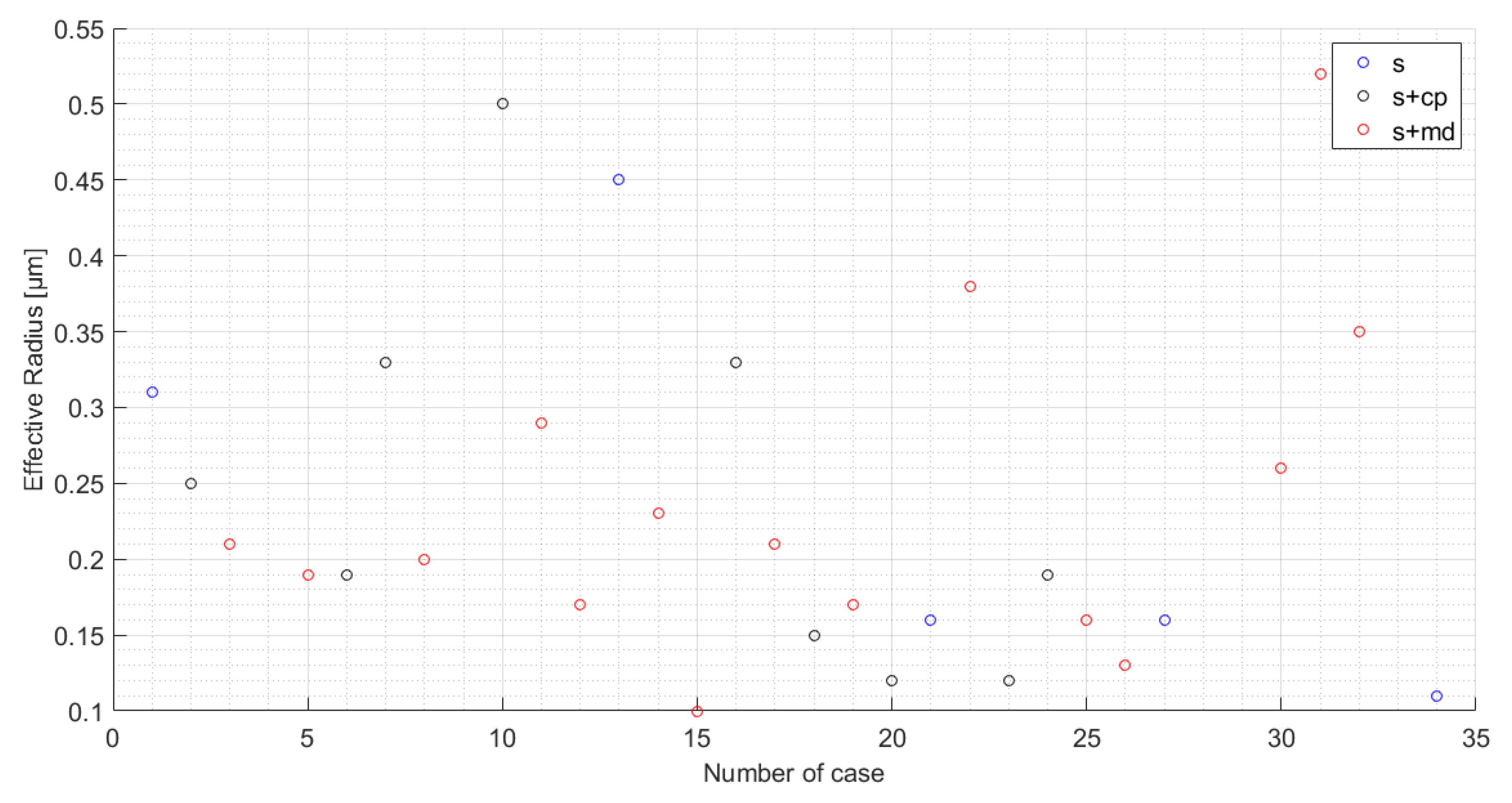
References
- Xu, B.; Cao, J.; Hansen, J.; Yao, T.; Joswia, D.R.; Wang, N.; Wu, G.; Wang, M.; Zhao, H.; Yang, W.; et al. Black soot and the survival of Tibetan glaciers. Proc. Natl. Acad. Sci. USA 2009, 106, 22114–22118. [Google Scholar] [CrossRef] [Green Version]
- Gautam, S. COVID-19: Air pollution remains low as people stay at home. Air Qual. Atmos. Health 2020, 13, 853–857. [Google Scholar] [CrossRef] [PubMed]
- Montgomerie, R.D. The Structural and Elemental Composition of Inhaled Particles in Ancient Egyptian Mummified Lungs; The University of Manchester: Manchester, UK, 2012; p. 269. [Google Scholar]
- Seinfeld, J. Air Polution: Physical and Chemical Fundamentals; McGraw-Hill: New York, NY, USA, 1975; ISBN-10 0070560420; ISBN-13 978-0070560420. [Google Scholar]
- Janicka, L.; Stachlewska, I.S.; Veselovskii, I.; Baars, H. Temporal variations in optical and microphysical properties of mineral dust and biomass burning aerosol derived from daytime Raman lidar observations over Warsaw, Poland. Atmos. Environ. 2017, 169, 162–174. [Google Scholar] [CrossRef]
- Baars, H.; Ansmann, A.; Ohneiser, K.; Haarig, M.; Engelmann, R.; Althausen, D.; Hanssen, I.; Gausa, M.; Pietruczuk, A.; Szkop, A.; et al. The unprecedented 2017–2018 stratospheric smoke event: Decay phase and aerosol properties observed with the EARLINET. Atmos. Chem. Phys. 2019, 19, 15183–15198. [Google Scholar] [CrossRef] [Green Version]
- Papanikolaou, C.A.; Giannakaki, E.; Papayannis, A.; Mylonaki, M.; Soupiona, O. Canadian biomass burning aerosol properties modification during a long-ranged event on August 2018. Sensors 2020, 20, 5442. [Google Scholar] [CrossRef]
- Nicolae, V.; Talianu, C.; Andrei, S.; Antonescu, B.; Ene, D.; Nicolae, D.; Dandocsi, A.; Toader, V.-E.; Ștefan, S.; Savu, T.; et al. Multiyear Typology of Long-Range Transported Aerosols over Europe. Atmosphere 2019, 10, 482. [Google Scholar] [CrossRef] [Green Version]
- Wiedinmyer, C.; Akagi, S.K.; Yokelson, R.J.; Emmons, L.K.; Al-Saadi, J.A.; Orlando, J.J.; Soja, A.J. The Fire INventory from NCAR (FINN): A high resolution global model to estimate the emissions from open burning. Geosci. Model. Dev. 2011, 4, 625–641. [Google Scholar] [CrossRef] [Green Version]
- Pan, X.; Ichoku, C.; Chin, M.; Bian, H.; Darmenov, A.; Colarco, P.; Ellison, L.; Kucsera, T.; Da Silva, A.; Wang, J.; et al. Six global biomass burning emission datasets: Intercomparison and application in one global aerosol model. Atmos. Chem. Phys. 2020, 20, 969–994. [Google Scholar] [CrossRef] [Green Version]
- Mahowald, N.; Ward, D.S.; Kloster, S.; Flanner, M.G.; Heald, C.L.; Heavens, N.G.; Hess, P.G.; Lamarque, J.F.; Chuang, P.Y. Aerosol impacts on climate and biogeochemistry. Annu. Rev. Environ. Resour. 2011, 36, 45–74. [Google Scholar] [CrossRef] [Green Version]
- Sassen, K.; Khvorostyanov, V.I. Cloud effects from boreal forest fire smoke: Evidence for ice nucleation from polarization lidar data and cloud model simulations. Environ. Res. Lett. 2008, 3, 25006. [Google Scholar] [CrossRef]
- Rosenfeld, D.; Sherwood, S.; Wood, R.; Donner, L. Climate effects of aerosol-cloud interactions. Science 2014, 343, 379–380. [Google Scholar] [CrossRef] [PubMed]
- Martins, E.P.; Bissell, A.N.; Morgan, K.K. Population differences in a lizard communicative display: Evidence for rapid change in structure and function. Anim. Behav. 1998, 56, 1113–1119. [Google Scholar] [CrossRef] [PubMed] [Green Version]
- Jacobson, M.Z. Strong radiative heating due to mixing state of black carbon in atmospheric aerosol. Nature 2001, 409, 695–697. [Google Scholar] [CrossRef] [PubMed]
- Reid, J.S.; Eck, T.F.; Christopher, S.A.; Koppman, R.; Dubovik, O.; Eleuterio, D.P.; Holben, B.N.; Reid, E.A.; Zhang, J. A review of biomass burning emissions part III: Intensive optical properties of biomass burning particles. Atmos. Chem. Phys. 2005, 5, 827–849. [Google Scholar] [CrossRef] [Green Version]
- Ortiz-Amezcua, P.; Luis Guerrero-Rascado, J.; Granados-Munõz, M.J.; Benavent-Oltra, J.A.; Böckmann, C.; Samaras, S.; Stachlewska, I.S.; Janicka, L.; Baars, H.; Bohlmann, S.; et al. Microphysical characterization of long-range transported biomass burning particles from North America at three EARLINET stations. Atmos. Chem. Phys. 2017, 17, 5931–5946. [Google Scholar] [CrossRef] [Green Version]
- Nicolae, D.; Nemuc, A.; Müller, D.; Talianu, C.; Vasilescu, J.; Belegante, L.; Kolgotin, A. Characterization of fresh and aged biomass burning events using multiwavelength Raman lidar and mass spectrometry. J. Geophys. Res. Atmos. 2013, 118, 2956–2965. [Google Scholar] [CrossRef]
- Haarig, M.; Ansmann, A.; Baars, H.; Jimenez, C.; Veselovskii, I.; Engelmann, R.; Althausen, D. Extreme levels of Canadian wildfire smoke in the stratosphere over central Europe—Part 2: Lidar study of depolarization and lidar ratios at 355, 532, and 1064 nm and of microphysical properties. Atmos. Chem. Phys. 2018, 18, 11847–11861. [Google Scholar] [CrossRef] [Green Version]
- Hu, Q.; Goloub, P.; Veselovskii, I.; Bravo-Aranda, J.A.; Elisabeta Popovici, I.; Podvin, T.; Haeffelin, M.; Lopatin, A.; Dubovik, O.; Pietras, C.; et al. Long-range-transported Canadian smoke plumes in the lower stratosphere over northern France. Atmos. Chem. Phys. 2019, 19, 1173–1193. [Google Scholar] [CrossRef] [Green Version]
- Weinzierl, B.; Sauer, D.; Esselborn, M.; Petzold, A.; Veira, A.; Rose, M.; Mund, S.; Wirth, M.; Ansmann, A.; Tesche, M.; et al. Microphysical and optical properties of dust and tropical biomass burning aerosol layers in the Cape Verde region-an overview of the airborne in situ and lidar measurements during SAMUM-2. Tellus Ser. B Chem. Phys. Meteorol. 2011, 63, 589–618. [Google Scholar] [CrossRef] [Green Version]
- Burton, S.P.; Ferrare, R.A.; Hostetler, C.A.; Hair, J.W.; Rogers, R.R.; Obland, M.D.; Butler, C.F.; Cook, A.L.; Harper, D.B.; Froyd, K.D. Aerosol classification using airborne High Spectral Resolution Lidar measurements-methodology and examples. Atmos. Meas. Tech. 2012, 5, 73–98. [Google Scholar] [CrossRef] [Green Version]
- Groß, S.; Esselborn, M.; Weinzierl, B.; Wirth, M.; Fix, A.; Petzold, A. Aerosol classification by airborne high spectral resolution lidar observations. Atmos. Chem. Phys. 2013, 13, 2487–2505. [Google Scholar] [CrossRef] [Green Version]
- Marenco, F.; Johnson, B.; Turnbull, K.; Newman, S.; Haywood, J.; Webster, H.; Ricketts, H. Airborne lidar observations of the 2010 Eyjafjallajkull volcanic ash plume. J. Geophys. Res. Atmos. 2011, 116, 1–15. [Google Scholar] [CrossRef]
- Murayama, T.; Müller, D.; Wada, K.; Shimizu, A.; Sekiguchi, M.; Tsukamoto, T. Characterization of Asian dust and Siberian smoke with multi-wavelength Raman lidar over Tokyo, Japan in spring 2003. Geophys. Res. Lett. 2004, 31, 1–5. [Google Scholar] [CrossRef] [Green Version]
- Veselovskii, I.; Whiteman, D.N.; Korenskiy, M.; Suvorina, A.; Kolgotin, A.; Lyapustin, A.; Wang, Y.; Chin, M.; Bian, H.; Kucsera, T.L.; et al. Characterization of forest fire smoke event near Washington, DC in summer 2013 with multi-wavelength lidar. Atmos. Chem. Phys. 2015, 15, 1647–1660. [Google Scholar] [CrossRef] [Green Version]
- Giannakaki, E.; Van Zyl, P.G.; Müller, D.; Balis, D.; Komppula, M. Optical and microphysical characterization of aerosol layers over South Africa by means of multi-wavelength depolarization and Raman lidar measurements. Atmos. Chem. Phys. 2016, 16, 8109–8123. [Google Scholar] [CrossRef] [Green Version]
- Baars, H.; Ansmann, A.; Althausen, D.; Engelmann, R.; Heese, B.; Mller, D.; Artaxo, P.; Paixao, M.; Pauliquevis, T.; Souza, R. Aerosol profiling with lidar in the Amazon Basin during the wet and dry season. J. Geophys. Res. Atmos. 2012, 117, 1–16. [Google Scholar] [CrossRef]
- Amiridis, V.; Zerefos, C.; Kazadzis, S.; Gerasopoulos, E.; Eleftheratos, K.; Vrekoussis, M.; Stohl, A.; Mamouri, R.E.; Kokkalis, P.; Papayannis, A.; et al. Impact of the 2009 Attica wild fires on the air quality in urban Athens. Atmos. Environ. 2012, 46, 536–544. [Google Scholar] [CrossRef]
- Balis, D.S.; Amiridis, V.; Zerefos, C.; Gerasopoulos, E.; Andreae, M.; Zanis, P.; Kazantzidis, A.; Kazadzis, S.; Papayannis, A. Raman lidar and sunphotometric measurements of aerosol optical properties over Thessaloniki, Greece during a biomass burning episode. Atmos. Environ. 2003, 37, 4529–4538. [Google Scholar] [CrossRef]
- Amiridis, V.; Balis, D.S.; Giannakaki, E.; Stohl, A.; Kazadzis, S.; Koukouli, M.E.; Zanis, P. Optical characteristics of biomass burning aerosols over Southeastern Europe determined from UV-Raman lidar measurements. Atmos. Chem. Phys. 2009, 9, 2431–2440. [Google Scholar] [CrossRef] [Green Version]
- Alados-Arboledas, L.; Müller, D.; Guerrero-Rascado, J.L.; Navas-Guzmán, F.; Pérez-Ramírez, D.; Olmo, F.J. Optical and microphysical properties of fresh biomass burning aerosol retrieved by Raman lidar, and star-and sun-photometry. Geophys. Res. Lett. 2011, 38, 1–5. [Google Scholar] [CrossRef]
- Müller, D.; Mattis, I.; Wandinger, U.; Ansmann, A.; Althausen, D.; Stohl, A. Raman lidar observations of aged Siberian and Canadian forest fire smoke in the free troposphere over Germany in 2003: Microphysical particle characterization. J. Geophys. Res. D Atmos. 2005, 110, 75–90. [Google Scholar] [CrossRef]
- Müller, D.; Ansmann, A.; Mattis, I.; Tesche, M.; Wandinger, U.; Althausen, D.; Pisani, G. Aerosol-type-dependent lidar ratios observed with Raman lidar. J. Geophys. Res. Atmos. 2007, 112, 1–11. [Google Scholar] [CrossRef]
- Ansmann, A.; Baars, H.; Tesche, M.; Müller, D.; Althausen, D.; Engelmann, R.; Pauliquevis, T.; Artaxo, P. Dust and smoke transport from Africa to South America: Lidar profiling over Cape Verde and the Amazon rainforest. Geophys. Res. Lett. 2009, 36, 2–6. [Google Scholar] [CrossRef]
- Adam, M.; Nicolae, D.; Belegante, L.; Stachlewska, I.; Janicka, L.; Szczepanik, D.; Mylonaki, M.; Papanikolaou, C.A.; Siomos, N.; Voudouri, K.A.; et al. Biomass burning events measured by lidars in EARLINET. Part II. Results and discussions. Atmos. Chem. Phys. Discuss. 2020. preprint. [Google Scholar] [CrossRef]
- Mylonaki, M.; Papayannis, A.; Papanikolaou, C.A.; Foskinis, R.; Soupiona, O.; Maroufidis, G.; Anagnou, D.; Kralli, E. Tropospheric vertical profiling of the aerosol backscatter coefficient and the particle linear depolarization ratio for different aerosol mixtures during the PANACEA campaign in July 2019 at Volos, Greece. Atmos. Environ. 2021, 247, 118184. [Google Scholar] [CrossRef]
- Mylonaki, M.; Giannakaki, E.; Papayannis, A.; Papanikolaou, C.A.; Komppula, M.; Nicolae, D.; Papagiannopoulos, N.; Amodeo, A.; Baars, H.; Soupiona, O. Aerosol type classification analysis using EARLINET multiwavelength and depolarization lidar observations. Atmos. Chem. Phys. 2021, 21, 2211–2227. [Google Scholar] [CrossRef]
- D’Amico, G.; Amodeo, A.; Mattis, I.; Freudenthaler, V.; Pappalardo, G. EARLINET Single Calculus Chain-technical andndash; Part 1: Pre-processing of raw lidar data. Atmos. Meas. Tech. 2016, 9, 491–507. [Google Scholar] [CrossRef] [Green Version]
- Mattis, I.; D’Amico, G.; Baars, H.; Amodeo, A.; Madonna, F.; Iarlori, M. EARLINET Single Calculus Chain—Technical—Part 2: Calculation of optical products. Atmos. Meas. Tech. 2016, 9, 3009–3029. [Google Scholar] [CrossRef] [Green Version]
- Veselovskii, I.; Kolgotin, A.; Griaznov, V.; Müller, D.; Wandinger, U.; Whiteman, D.N. Inversion with regularization for the retrieval of tropospheric aerosol parameters from multiwavelength lidar sounding. Appl. Opt. 2002, 41, 3685. [Google Scholar] [CrossRef] [Green Version]
- Kokkalis, P.; Soupiona, O.; Papanikolaou, C.A.; Foskinis, R.; Mylonaki, M.; Solomos, S.; Vratolis, S.; Vasilatou, V.; Kralli, E.; Anagnou, D.; et al. Radiative effect and mixing processes of a long-lasting dust event over athens, greece, during the COVID-19 period. Atmosphere 2021, 12, 318. [Google Scholar] [CrossRef]
- Pappalardo, G.; Amodeo, A.; Apituley, A.; Comeron, A.; Freudenthaler, V.; Linné, H.; Ansmann, A.; Bösenberg, J.; D’Amico, G.; Mattis, I.; et al. EARLINET: Towards an advanced sustainable European aerosol lidar network. Atmos. Meas. Tech. 2014, 7, 2389–2409. [Google Scholar] [CrossRef] [Green Version]
- Draxler, R.R.; Hess, G.D. An overview of the HYSPLIT_4 modelling system for trajectories, dispersion and deposition. Aust. Meteorol. Mag. 1998, 47, 295–308. [Google Scholar]
- Giglio, L.; Descloitres, J.; Justice, C.O.; Kaufman, Y.J. An enhanced contextual fire detection algorithm for MODIS. Remote Sens. Environ. 2003, 87, 273–282. [Google Scholar] [CrossRef]
- Basart, S.; PéRez, C.; Nickovic, S.; Cuevas, E.; Baldasano, J.M. Development and evaluation of the BSC-DREAM8b dust regional model over northern Africa, the mediterranean and the middle east. Tellus Ser. B Chem. Phys. Meteorol. 2012, 64, 18539. [Google Scholar] [CrossRef] [Green Version]
- Bougiatioti, A.; Bezantakos, S.; Stavroulas, I.; Kalivitis, N.; Kokkalis, P.; Biskos, G.; Mihalopoulos, N.; Papayannis, A.; Nenes, A. Biomass-burning impact on CCN number, hygroscopicity and cloud formation during summertime in the eastern Mediterranean. Atmos. Chem. Phys. 2016, 16, 7389–7409. [Google Scholar] [CrossRef] [Green Version]
- Terzi, E.; Argyropoulos, G.; Bougatioti, A.; Mihalopoulos, N.; Nikolaou, K.; Samara, C. Chemical composition and mass closure of ambient PM10 at urban sites. Atmos. Environ. 2010, 44, 2231–2239. [Google Scholar] [CrossRef]
- Remoundaki, E.; Papayannis, A.; Kassomenos, P.; Mantas, E.; Kokkalis, P.; Tsezos, M. Influence of saharan dust transport events on PM2.5 concentrations and composition over Athens. Water Air Soil Pollut. 2013, 224, 1373. [Google Scholar] [CrossRef]
- Klett, J.D. Stable analytical inversion solution for processing lidar returns. Appl. Opt. 1981, 20, 211. [Google Scholar] [CrossRef] [Green Version]
- Klett, J.D. Lidar inversion with variable backscatter/extinction ratios. Appl. Opt. 1985, 24, 1638. [Google Scholar] [CrossRef]
- Papayannis, A.; Amiridis, V.; Mona, L.; Tsaknakis, G.; Balis, D.; Bösenberg, J.; Chaikovski, A.; De Tomasi, F.; Grigorov, I.; Mattis, I.; et al. Systematic lidar observations of Saharan dust over Europe in the frame of EARLINET (2000–2002). J. Geophys. Res. Atmos. 2008, 113, 1–17. [Google Scholar] [CrossRef] [Green Version]
- Groß, S.; Tesche, M.; Freudenthaler, V.; Toledano, C.; Wiegner, M.; Ansmann, A.; Althausen, D.; Seefeldner, M. Characterization of Saharan dust, marine aerosols and mixtures of biomass-burning aerosols and dust by means of multi-wavelength depolarization and Raman lidar measurements during SAMUM 2. Tellus Ser. B Chem. Phys. Meteorol. 2011, 63, 706–724. [Google Scholar] [CrossRef]
- Burton, S.P.; Ferrare, R.A.; Vaughan, M.A.; Omar, A.H.; Rogers, R.R.; Hostetler, C.A.; Hair, J.W. Aerosol classification from airborne HSRL and comparisons with the CALIPSO vertical feature mask. Atmos. Meas. Tech. 2013, 6, 1397–1412. [Google Scholar] [CrossRef] [Green Version]
- Ansmann, A.; Riebesell, M.; Weitkamp, C. Measurement of atmospheric aerosol extinction profiles with a Raman lidar. Opt. Lett. 1990, 15, 746. [Google Scholar] [CrossRef] [PubMed]
- Chemyakin, E.; Müller, D.; Burton, S.; Kolgotin, A.; Hostetler, C.; Ferrare, R. Arrange and average algorithm for the retrieval of aerosol parameters from multiwavelength high-spectral-resolution lidar/Raman lidar data. Appl. Opt. 2014, 53, 7252. [Google Scholar] [CrossRef] [PubMed]
- Müller, D.; Wandinger, U.; Ansmann, A. Microphysical particle parameters from extinction and backscatter lidar data by inversion with regularization: Theory. Appl. Opt. 1999, 38, 2346. [Google Scholar] [CrossRef]
- Samaras, S.; Nicolae, D.; Böckmann, C.; Vasilescu, J.; Binietoglou, I.; Labzovskii, L.; Toanca, F.; Papayannis, A. Using Raman-lidar-based regularized microphysical retrievals and Aerosol Mass Spectrometer measurements for the characterization of biomass burning aerosols. J. Comput. Phys. 2015, 299, 156–174. [Google Scholar] [CrossRef]
- Soupiona, O.; Papayannis, A.; Kokkalis, P.; Foskinis, R.; Sánchez Hernández, G.; Ortiz-Amezcua, P.; Mylonaki, M.; Papanikolaou, C.A.; Papagiannopoulos, N.; Samaras, S.; et al. EARLINET observations of Saharan dust intrusions over the northern Mediterranean region (2014–2017): Properties and impact on radiative forcing. Atmos. Chem. Phys. 2020, 20, 15147–15166. [Google Scholar] [CrossRef]
- Wandinger, U.; Müller, D.; Böckmann, C.; Althausen, D.; Matthias, V.; Bösenberg, J.; Weiß, V.; Fiebig, M.; Wendisch, M.; Stohl, A.; et al. Optical and microphysical characterization of biomass-burning and industrial-pollution aerosols from multiwavelength lidar and aircraft measurements. J. Geophys. Res. Atmos. 2002, 107, 8125. [Google Scholar] [CrossRef]
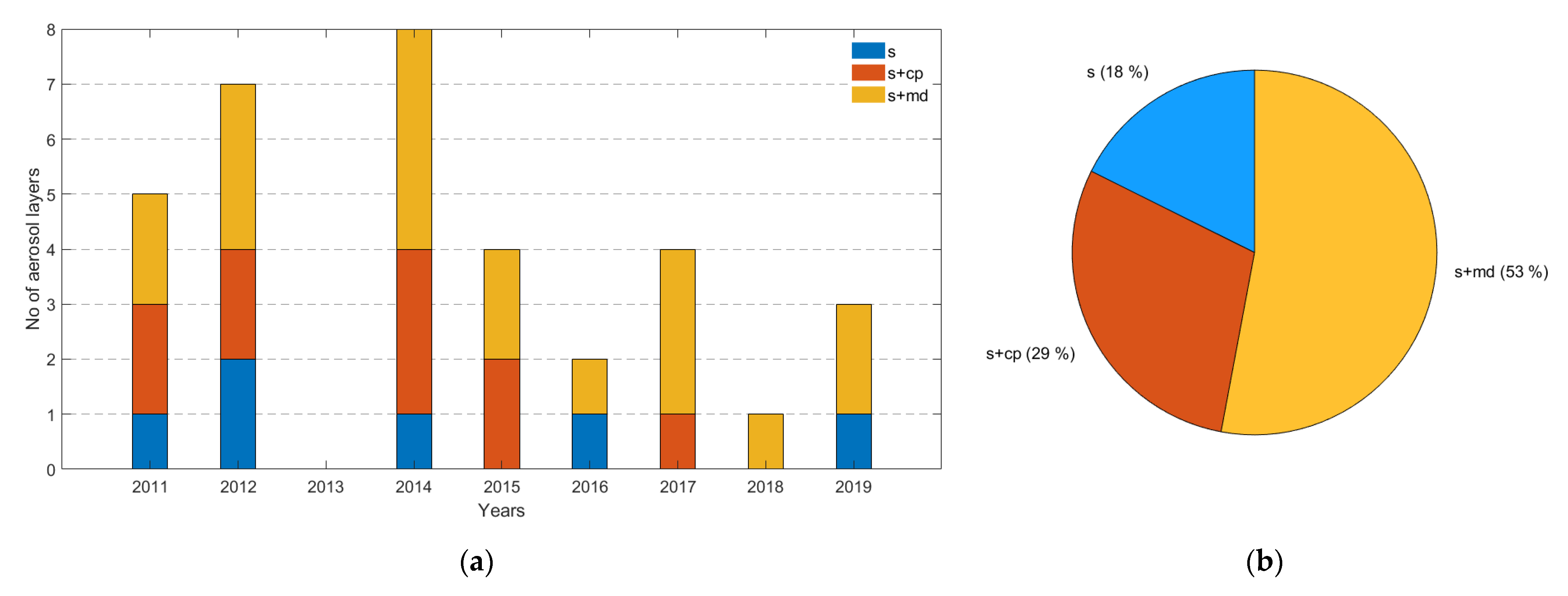
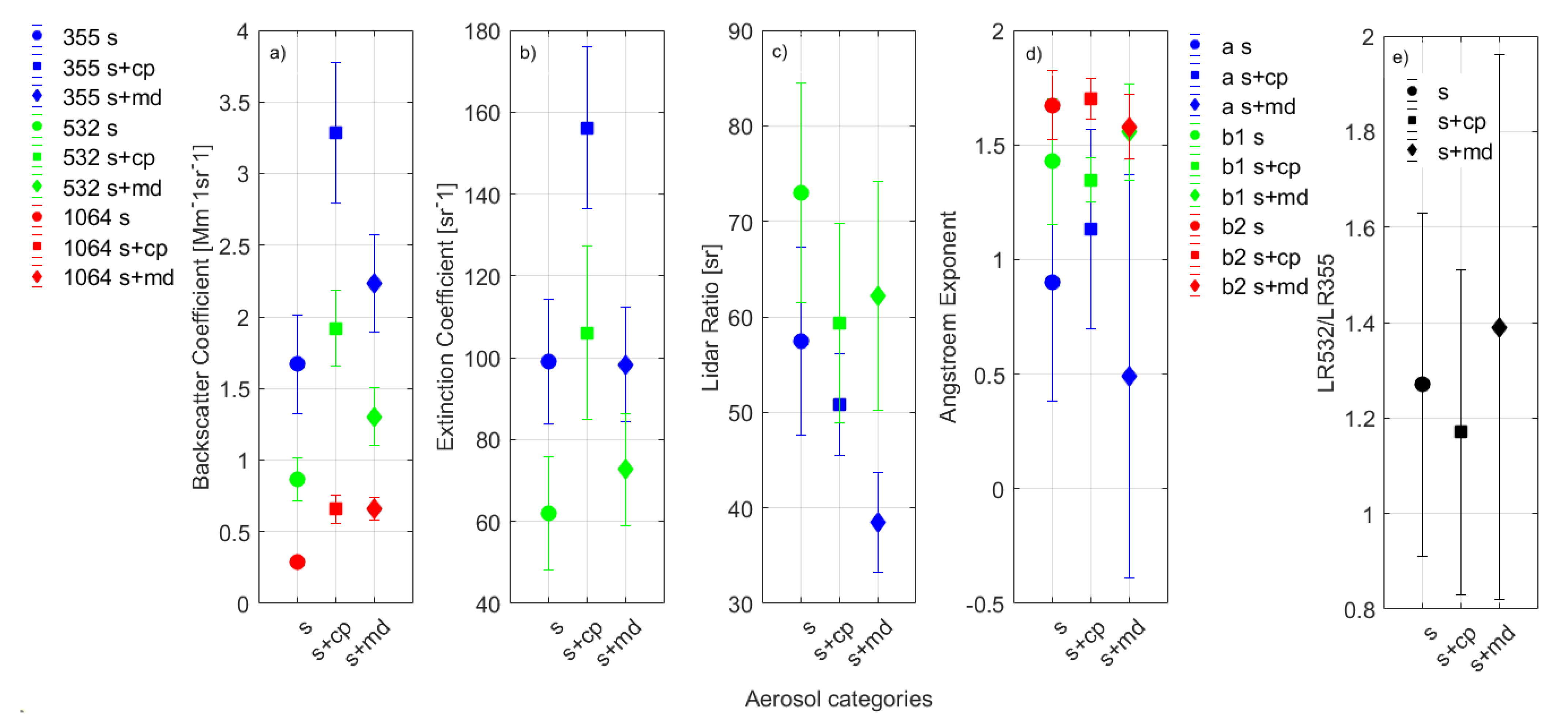
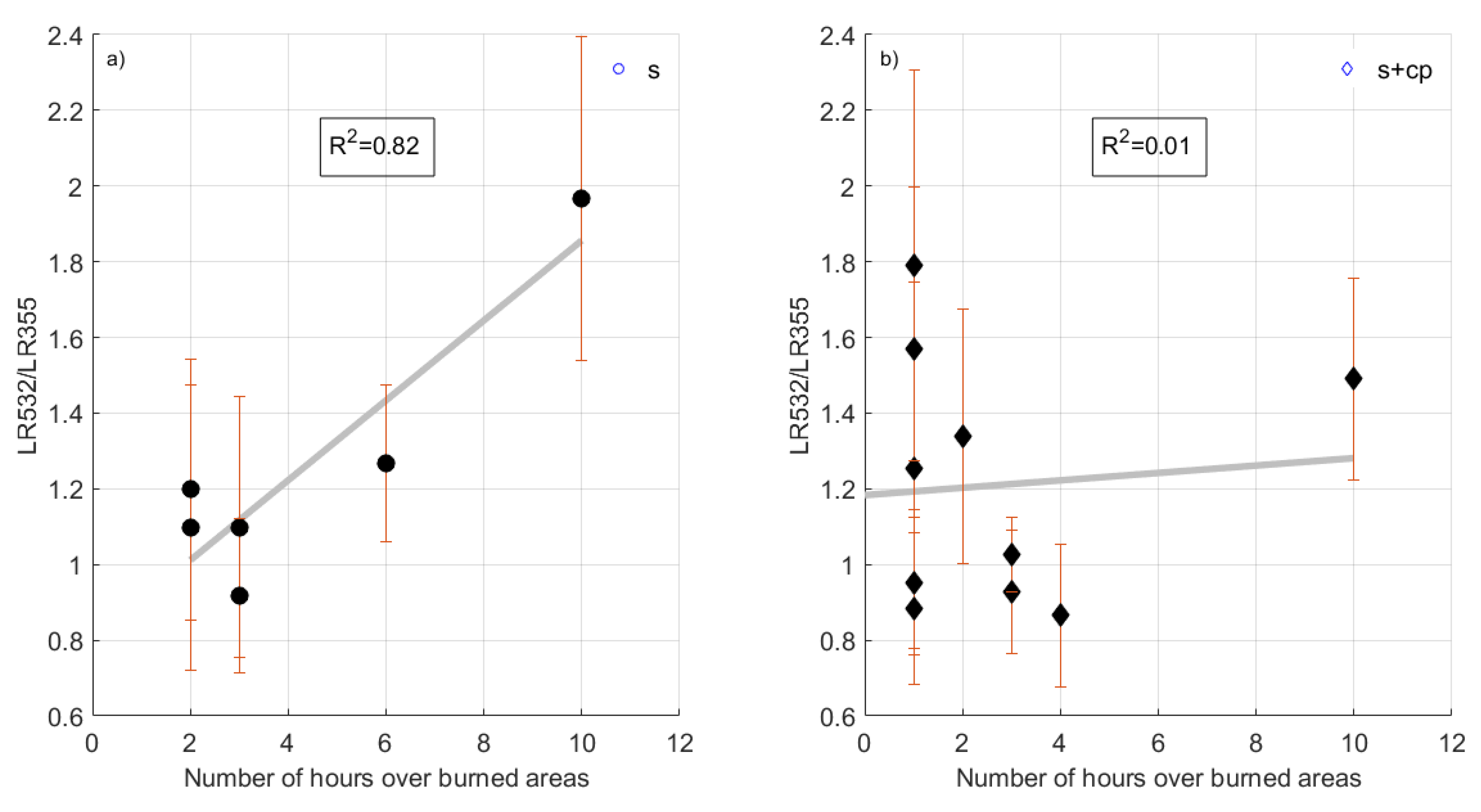
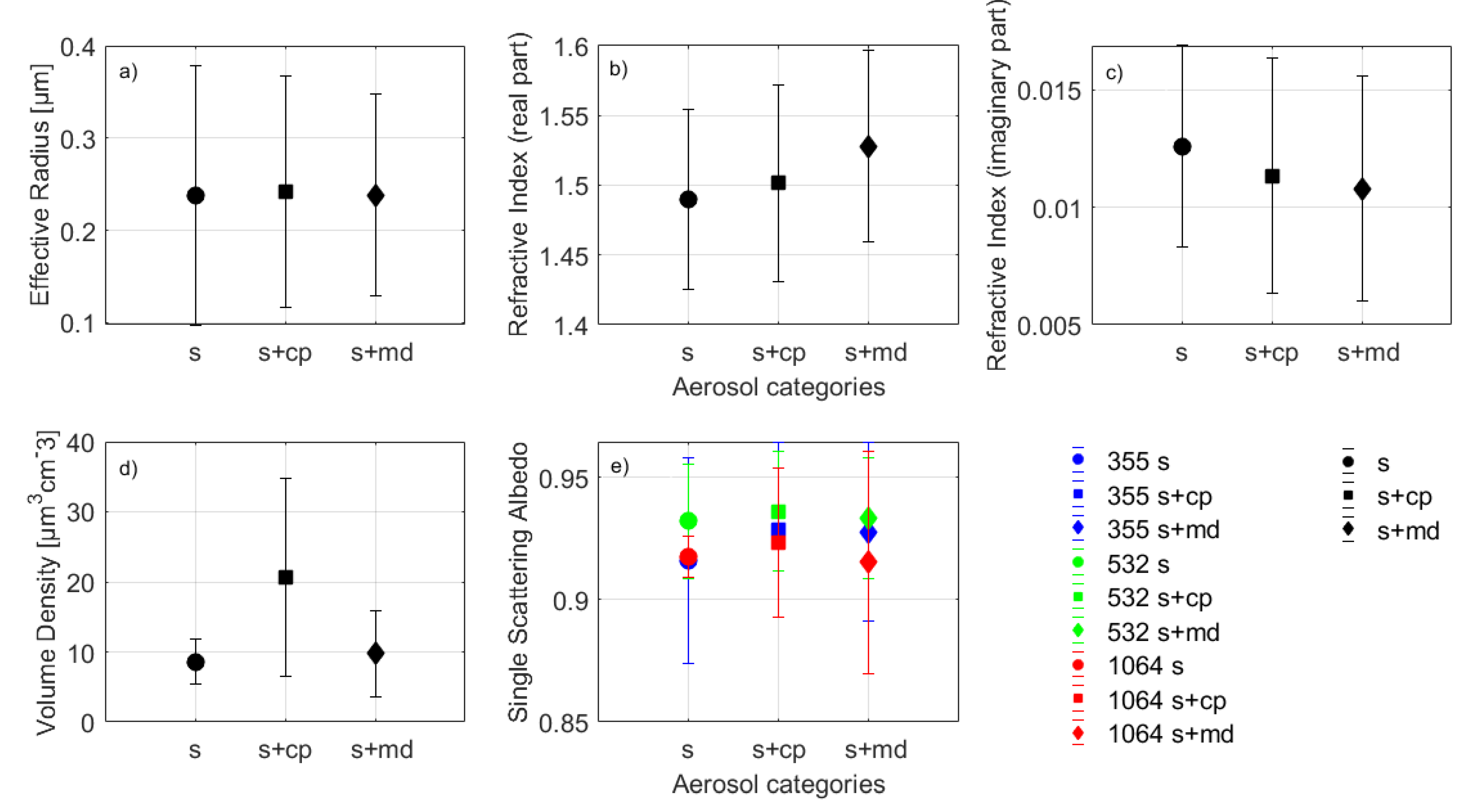
| Aerosol Category | ||||
|---|---|---|---|---|
| s | s+cp | s+md | ||
| Optical properties | ||||
| LR 355 nm (sr) | this study | 57 ± 10 | 51 ± 5 * | 39 ± 5 |
| literature | 21–67 | 35–92 | ||
| LR 532 nm (sr) | this study | 73 ± 11 | 59 ± 10 * | 62 ± 12 |
| literature | 26–80 | 32–75 | ||
| AE ext 355/532 | this study | 0.90 ± 0.52 | 1.13 ± 0.44 * | 0.49 ± 0.88 |
| literature | 0.64–2.3 | 0.50–1.70 | ||
| AE bsc 355/532 | this study | 1.43 ± 0.27 | 1.35 ± 0.09 * | 1.56 ± 0.21 |
| literature | ~1.90 | 0.44–1.50 | ||
| AE bsc 532/1064 | this study | 1.67 ± 0.15 | 1.70 ± 0.09 * | 1.58 ± 0.14 |
| literature | ~1.90 | 0.44–1.50 | ||
| LR532/LR355 | this study | 1.27 ± 0.36 | 1.17 ± 0.34 * | 1.39 ± 0.57 |
| literature | 0.9–1.4 | 0.7–1.0 | ||
| References | [18,22,25,28,32,33,58] | [27,35,59] | ||
| Microphysical properties | ||||
| reff (μm) | this study | 0.24 ± 0.14 | 0.24 ± 0.13 * | 0.24 ± 0.11 |
| literature | 0.13–0.44 | 0.17–0.45 | ||
| mR | this study | 1.49 ± 0.06 | 1.50 ± 0.07 * | 1.53 ± 0.07 |
| literature | 1.37–1.6 | 1.37–1.50 | ||
| mI | this study | 0.013 ± 0.004 i | 0.011 ± 0.005 i * | 0.011 ± 0.005 i |
| literature | 0.001–0.053 i | 0.004–0.007 i | ||
| vd (μm−3cm−3) | this study | 8.6 ± 3.2 | 20.7 ± 14.1 * | 9.7 ± 6.1 |
| literature | 8–50 | 7.4–24.0 | ||
| SSA 355 nm | this study | 0.916 ± 0.042 | 0.929 ± 0.036 * | 0.928 ± 0.037 |
| literature | 0.760–0.890 | 0.948–0.964 | ||
| SSA 532 nm | this study | 0.932 ± 0.023 | 0.936 ± 0.024 * | 0.933 ± 0.025 |
| literature | 0.790–0.997 | 0.937–0.958 | ||
| SSA 1064 nm | this study | 0.918 ± 0.008 | 0.923 ± 0.031 * | 0.915 ± 0.045 * |
| literature | 0.740–0.980 | |||
| References | [5,17,18,19,25,26,27,30,35,58,60] | [5,35,59] | ||
Publisher’s Note: MDPI stays neutral with regard to jurisdictional claims in published maps and institutional affiliations. |
© 2021 by the authors. Licensee MDPI, Basel, Switzerland. This article is an open access article distributed under the terms and conditions of the Creative Commons Attribution (CC BY) license (https://creativecommons.org/licenses/by/4.0/).
Share and Cite
Mylonaki, M.; Papayannis, A.; Anagnou, D.; Veselovskii, I.; Papanikolaou, C.-A.; Kokkalis, P.; Soupiona, O.; Foskinis, R.; Gidarakou, M.; Kralli, E. Optical and Microphysical Properties of Aged Biomass Burning Aerosols and Mixtures, Based on 9-Year Multiwavelength Raman Lidar Observations in Athens, Greece. Remote Sens. 2021, 13, 3877. https://doi.org/10.3390/rs13193877
Mylonaki M, Papayannis A, Anagnou D, Veselovskii I, Papanikolaou C-A, Kokkalis P, Soupiona O, Foskinis R, Gidarakou M, Kralli E. Optical and Microphysical Properties of Aged Biomass Burning Aerosols and Mixtures, Based on 9-Year Multiwavelength Raman Lidar Observations in Athens, Greece. Remote Sensing. 2021; 13(19):3877. https://doi.org/10.3390/rs13193877
Chicago/Turabian StyleMylonaki, Maria, Alexandros Papayannis, Dimitra Anagnou, Igor Veselovskii, Christina-Anna Papanikolaou, Panagiotis Kokkalis, Ourania Soupiona, Romanos Foskinis, Marilena Gidarakou, and Eleni Kralli. 2021. "Optical and Microphysical Properties of Aged Biomass Burning Aerosols and Mixtures, Based on 9-Year Multiwavelength Raman Lidar Observations in Athens, Greece" Remote Sensing 13, no. 19: 3877. https://doi.org/10.3390/rs13193877
APA StyleMylonaki, M., Papayannis, A., Anagnou, D., Veselovskii, I., Papanikolaou, C.-A., Kokkalis, P., Soupiona, O., Foskinis, R., Gidarakou, M., & Kralli, E. (2021). Optical and Microphysical Properties of Aged Biomass Burning Aerosols and Mixtures, Based on 9-Year Multiwavelength Raman Lidar Observations in Athens, Greece. Remote Sensing, 13(19), 3877. https://doi.org/10.3390/rs13193877







